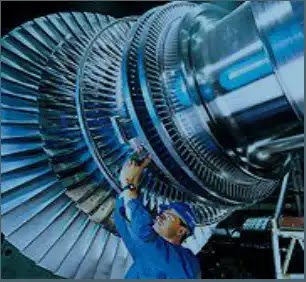Marine Engineering Knowledge LEC 2 | Marine Courses Center
welcome to Marine Courses Center today we will complete marine engineering & nautical engineering & naval architecture and marine engineering Marine Engineering Knowledge LEC 1 | Marine Courses CenterMarine Engineering Knowledge LEC 2 | Marine Courses CenterLecture 3 A heat engine is a machine that converts thermal energy to mechanical output.
Heat engines are divided to two types :
A. External combustion engines.
B. Internal combustion engines.
A-External combustion engines:

In this type combustion takes place outside the engine same as steam turbines which use steam to run , Steam is produced by a boiler.
Steam turbine:

is a mechanical device that extracts thermal energy from pressurized steam and converts it into rotary motion, here the steam is expanded to produce a high – speed steam current which press against vanes to rotate an impeller.
B- burning engines:
The internal combustion engine is an engine during which the combustion of fuel occurs in a very combustion chamber. the expansion of the extreme temperature and Pressure gases, directly applies force to a movable component of the engine, like the pistons in diesel engines or turbine blades in turbine and by moving it over a distance, generate useful energy.
Diesel engines:

In this type of engines the compression ration is enough (15/1) to generate the pressure and temperature which are enough for self ignition of the injected fuel it is called compression ignition engine C.I.E.
Gas turbine:
is an internal combustion engine , it consists of three main parts:
1- air compressor :
suck air from atmosphere and compress it to the combustion chamber.
2- combustion chamber :
the combustion is happening due to the injection of fuel and compressed air and will produce gases with high pressure and temperature apply force to turbine blades which will rotate in
high speed.
3- turbine :
consists of a wheels with blades fixed on a shaft , when the gases apply force to the blades they rotate the wheels with the shaft and run with high speed. The rotation of the shaft is the useful mechanical output.

WishlistRead More
MCC
Ship stability LECT 1
MCC
(0 review)
271
students
0
$20.00

WishlistRead More
MCC
Celestial Navigation & Ship stability ( Basic )
MCC
(0 review)
39
students
0
$68.00

WishlistRead More
MCC
COURSE TITLE Introduction to Navigation ( Basic for chart work )
MCC
(0 review)
211
students
0
$400.00

WishlistRead More
MCC
TERRESTRIAL NAVIGATION ( Sailing )
MCC
(0 review)
102
students
0
$100.00

WishlistRead More
MCC
Cargo Calculations Live lecture
MCC
(0 review)
221
students
0
$20.00

WishlistRead More
MCC
Celestial Navigation Basics
MCC
(0 review)
239
students
0
$36.00

WishlistRead More
MCC
Ship stability LECT 2
MCC
(0 review)
358
students
0
$12.00

WishlistRead More
MCC
LSA CODE
MCC
(0 review)
367
students
0
Free
check our free lectures on our facebook page Marine Courses Center
Check also our related course for OOW and For 2nd Mate and chief Mate
- Ship stability LECT 1
- Ship stability LECT 2
- Celestial Navigation LECT 1 | The Concept Of Celestial Sphere
- Celestial Navigation LECT 2 | Systems Of Coordinate Of Celestial Sphere
- Celestial Navigation LECT 3 | Systems Of Coordinate Of Celestial Sphere
- Celestial Navigation LECT 4 | Systems Of Coordinate Of Celestial Sphere Part 3
- Celestial Navigation LECT 5 | Chapter 3 Diurnal motion Celestial Navigation
- Celestial Navigation LECT 6 | Chapter 4 Annual Motion
if you have any question kindly please contact with me via ICQ and here how to contact with me via ICQ click here



